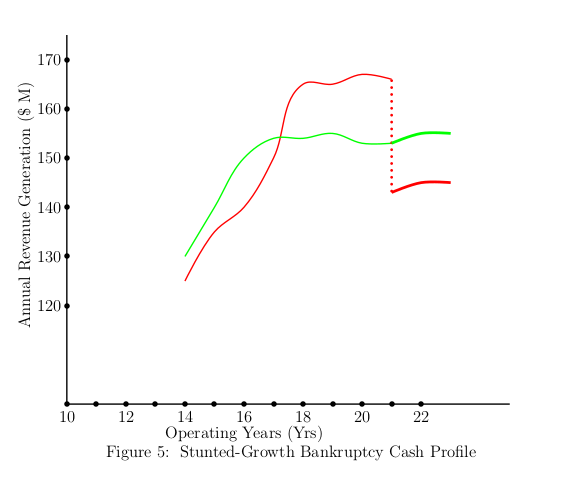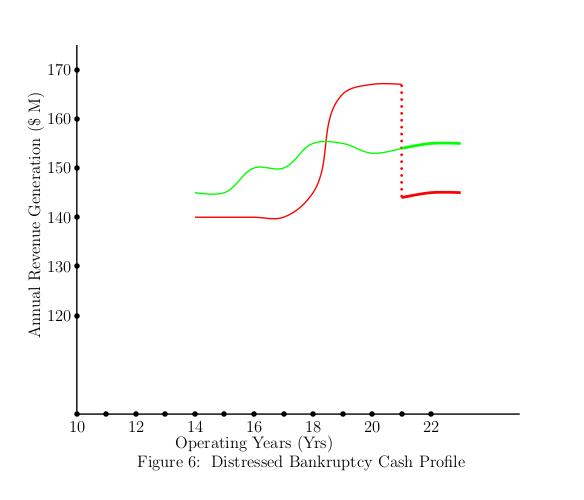|
|
Enhance Knowledge
| EnhKnowTM
,
LLC
Technology Brokerage & Royalty Servicing |
|
|
|
|
|
|
Business
Communications |
|
|
In Perspective: Bankruptcy,
Reorganization and Viability Analysis |
|
Published: June 25, 2020 |
Original Media: This publication |
|
Updated: None
|
Admittedly, the bankruptcy protection filing of every company is unique
to the company. Yet there are discernable similarities between many of
them. The financial profile of a bankruptcy company generally falls in
one of three forms as depicted in Figs 1 – 3, and depends on the stage
of evolution of the company along the trajectory of the Product Life
Cycle curve as defined by the primary product of its Core Business, as is profiled through Fig.1 Commodity
Bankruptcy, Fig 2 Stunted-Growth Bankruptcy, and Fig 3 Distressed
Bankruptcy: which are also delineated presently in eliciting their
differences, while noting that the green profiles represent cash inflow
while the red profile represents cash outflow
The
Commodity Bankruptcy Company represents the collection of companies that
have evolved into the Commodity Stage of the Product Life Cycle at the
time of filing
for bankruptcy protection, and is as depicted in Fig 1, and is
|
|
|
|
characterized by near aligned evolution of the cash in- and out-
flows profile prior to the filing of the
bankruptcy protection. Such bankruptcy types are described by the
bankruptcy filings of General Motors of 2009 and of McDermott
International of 2019. As would be further noticed, the drop of the cash
inflow (the green line) to a level below the cash outflow (red line) happens over a span of time,
the expanse of which depends on the operations but generally is
consequent on interruptions of operations
The Stunted-Growth Bankruptcy Company represents the collection of companies that
are still evolving through the Growth Stage of the Product Life Cycle at
the time of filing
for bankruptcy protection, and is as depicted in Fig 2, and is
characterized by near aligned upward evolution of the
|
|
|
|
cash in- and out- flows profile, as characteristic of Growth Stage, prior to the filing of the
bankruptcy protection. As would be further noticed, in this conditions
of bankruptcy filing the cash
inflow does not fall below the cash outflow but rather gets stunted and
flattens out while the cash outflow increases past the inflow before
stabilizing and effecting sustained negative differential cash flow over a span of time,
the expanse of which depends on the operations but generally happens
with interruptions of Market Participation as forced by the Business
Model
The Distressed Bankruptcy Company represents the collection of companies that
are evolving through any of the product growth stages of the Product
Life Cycle curve at the time of filing for bankruptcy protection, and is as
depicted in Fig 3, and is characterized by gradually increasing cash
inflow and gentle |
|
|
|
correspondingly upward gradient of the cash outflows profile both
indicative of steady growth, but then suffers a near Step-Jump increase
of cash outflow-demand forcing the filing of the bankruptcy protection. As would
be further noticed, there occurred neither drop nor flattening of the
cash inflow profile as with the previous cases but rather a an almost
Step Jump of
the cash outflow that is indicative of a default in any of debt repayment
constructs creating Distress operations conditions.
The relationship of the assets to debt at the moment of filing
of the
bankruptcy effectively defines the conditions of bankruptcy usually
documented as the Disclosure on which the
Reorganization Plan must be based. The reorganization is essentially defined
by the dotted lines that drop vertically from the cash outflow to a
lower level than the cash inflow.
Effectively, irrespective of the form of the Disclosure, the
reorganization always requires the downward folding of the debt stream
to a level lower than the cash inflow stream as shown in Fig 4 – 6 such that
the corporation enjoys net positive cash flow again. |
 |
 |
 |
|
As such, bankruptcy reorganization necessarily focuses on the
financial design of the Disclosure to develop yet again a state of self support of
the company. Very commonly most assets-secured debts are
preferentially converted to stocks in the new company so that the
corporation continues to own the assets with which to operate the
business after emergence from the Court-protection. Other similar debt
conversions are made so that the corporation owns all crucial
operational assets required to sustain its operations.
While the presentation defines the essential approach, the
implementation, of course, is case-specific, and must be addressed
singular to each bankruptcy filing. All the same, in essence, each of the
debt components is examined for the purposes of modification in a manner
that is acceptable to the creditors. However, while the restructuring
is, often times, readily constructed and packaged as Reorganization Plan, the
issue of interest is whether or not the proposed changes will have only
all the intended consequences, given the well known invariable
consequential outcome of
unintended consequences that attend intended consequences. The
considerations then become the predictive assessment of all the possible unintended consequences of the
Reorganization Plan adopted to force down the cash outflow stream below
the cash inflow stream into creating a positive differential between the
cash in- and out flows, and enable positive
cash-flow.
For one thing, the Reorganization Plan, often, changes the markets of
participation of the post-emergence corporation ever so much that the
initial post-emergence market allocation will be different. So then
there is the need to determine if the new market allocation and sales
model will provide viable basis of operating the company. Another
critical consideration is the alignment between the organization
structure and the production operations relative to the gross margins;
this analysis is crucial because the cost structure and pricing policy
adopted may not always be coincident with those prevailed upon the
business by the sum total of business planning for operating the
business, going forward, as reflected by the operations viability
analysis datasets as shown in the
datasets
graphical plots that must be constructed in capture of the business
operations of the corporation The computational analysis of the myriad factors, and more so the
Production Analytics, to the end of assessing the operational cost
structure, are some of the mission-critical objects of the Reorganization
Plan Viability analysis that is required to be
performed as necessary component of the legal resolution of bankruptcy
filings, and that is performed in course of the Bankruptcy
Reorganization Viability Analytics service. |
|
|
|
|
|
|
|
|